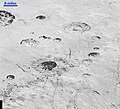Fichier:PIA20200-Pluto-BurneyBasin-CratersPlains-20150714.jpg

Taille de cet aperçu : 658 × 599 pixels. Autres résolutions : 264 × 240 pixels | 527 × 480 pixels | 843 × 768 pixels | 1 125 × 1 024 pixels | 2 249 × 2 048 pixels | 5 087 × 4 632 pixels.
Fichier d’origine (5 087 × 4 632 pixels, taille du fichier : 1,31 Mio, type MIME : image/jpeg)
Historique du fichier
Cliquer sur une date et heure pour voir le fichier tel qu'il était à ce moment-là.
| Date et heure | Vignette | Dimensions | Utilisateur | Commentaire | |
|---|---|---|---|---|---|
| actuel | 6 décembre 2015 à 18:28 |  | 5 087 × 4 632 (1,31 Mio) | Drbogdan | User created page with UploadWizard |
Utilisation du fichier
La page suivante utilise ce fichier :
Usage global du fichier
Les autres wikis suivants utilisent ce fichier :
- Utilisation sur ca.wiki.x.io
- Utilisation sur en.wiki.x.io
- Utilisation sur es.wiki.x.io

